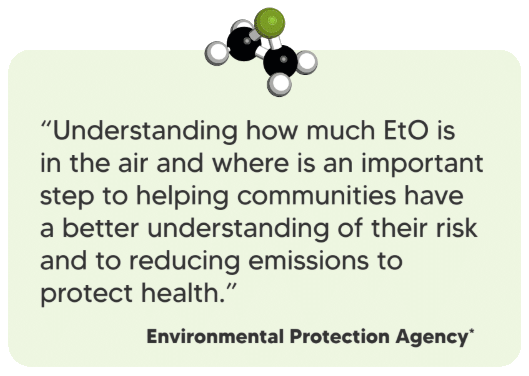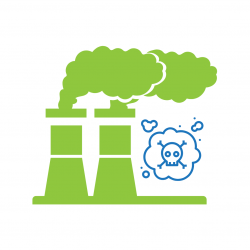This blog identifies key points of the proposed rule, and offers businesses guidance on remaining compliant.
On December 10, 2024, the U.S. Environmental Protection Agency (EPA) proposed amendments to the National Emission Standards for Hazardous Air Pollutants (NESHAP) for the Polyether Polyols Production industry (PEPO NESHAP). Though not yet finalized, these amendments aim to significantly reduce emissions of hazardous air pollutants (HAPs), including ethylene oxide (EtO), a chemical known to pose serious health risks, particularly in overburdened communities.

Key Highlights
The proposed amendments include stringent new requirements aimed at reducing harmful emissions from PEPO production facilities, which produce chemicals used in polyurethane foams, lubricants, adhesives, cosmetics, and soaps. Key highlights include:

Reducing Emissions
- EtO emissions would decrease by approximately 14 tons per year (tpy).
- Total HAP emissions would decline by 157 tpy.
- Excess HAP flare emissions would be reduced by an additional 75 tpy.
Monitoring and Reporting Requirements
- Facilities using EtO must conduct fenceline monitoring every five days using EPA Method 327.
- Annual average EtO concentrations exceeding the action level of 0.2 µg/m³ at the fenceline will trigger mandatory root cause analysis and corrective actions.
- Monitoring data will be publicly available through the EPA’s WebFIRE database.
Operational and Compliance Deadlines
- Fenceline monitoring must commence within two years of the final rule.
- Full compliance, including corrective action plans, is required within three years of the final rule’s publication.
Why This Matters to Businesses
If finalized, these proposed changes will require significant operational adjustments for businesses in the PEPO production sector. Due to its carcinogenic properties, the EPA’s increased focus on EtO underscores the importance of proactive compliance planning. Facilities must not only meet stricter emission limits but also invest in monitoring systems, fenceline monitoring programs, and enhanced reporting practices to avoid enforcement actions and reputational risks.
Many of these regulatory shifts mirror the requirements introduced under the current HON MACT regulation, which sets stringent emission standards for hazardous organic pollutants. Businesses that have navigated HON MACT compliance will recognize the need for advanced monitoring, control technologies, and data-driven compliance strategies, making early preparation for PEPO NESHAP essential.
How Montrose Can Support Your Compliance Efforts
Navigating the complexities of the proposed PEPO NESHAP can be challenging, but Montrose Environmental Group offers comprehensive support through our integrated expertise and innovative technologies. Here’s how we can help:
Fenceline Monitoring
We specialize in developing and executing comprehensive fenceline monitoring programs that meet EPA Method 327 requirements. Our services include:
- Developing facility-specific monitoring plans and determining site selection.
- Installation of sampling locations and deployment of canisters to collect samples every five days as required.
- Ensuring accurate and timely sample analysis through Enthalpy Analytical, Montrose’s EPA Method 327-accredited laboratory.
- Providing insight and data visualization through the Sensible EDP™ platform, enabling rapid root cause identification and corrective actions.
We’ve successfully deployed similar pilot programs under the HON MACT regulations, demonstrating our ability to provide scalable and effective solutions.
Comprehensive Stack Testing Services
Our stack testing capabilities ensure accurate performance evaluations of emission control systems that align with regulatory standards. These services are critical for complying with the EPA’s proposed performance testing requirements every five years.
Wastewater and Process Fluids Expertise
We specialize in advanced treatment solutions for wastewater and process fluids. These solutions can help address the proposed tighter controls on EtO emissions from wastewater streams, ensuring compliance while supporting sustainability goals.
Next Steps for Businesses
Given the potential impact of the proposed PEPO NESHAP rule, businesses should begin preparing now. Here are a few ways to get started:
- Review the EPA’s proposal and understand how it applies to their facilities.
- Establish pilot programs to baseline current emissions and identify areas for improvement.
- Partner with experienced environmental service providers like Montrose to develop comprehensive compliance strategies.
Why Choose Montrose?
Montrose Environmental Group combines human expertise with cutting-edge technology to deliver end-to-end compliance solutions. With a proven track record in stack testing, fenceline monitoring, and advanced wastewater treatment, we help businesses navigate complex regulations while minimizing operational disruptions.
Having worked extensively with facilities regulated under HON MACT, we bring a deep understanding of how to manage compliance with stringent hazardous air pollutant regulations. Our expertise in emissions monitoring, control strategies, and regulatory reporting allows us to provide tailored solutions that ensure both PEPO NESHAP and HON MACT compliance.
Contact us to learn more about how we can support your compliance efforts under the proposed PEPO NESHAP and help you stay ahead of evolving regulations.
Need help with an Ethylene Oxide emissions monitoring project?
Ready to see the platform or have a question for our experts? Use the form below.